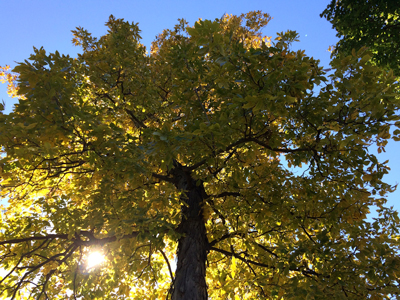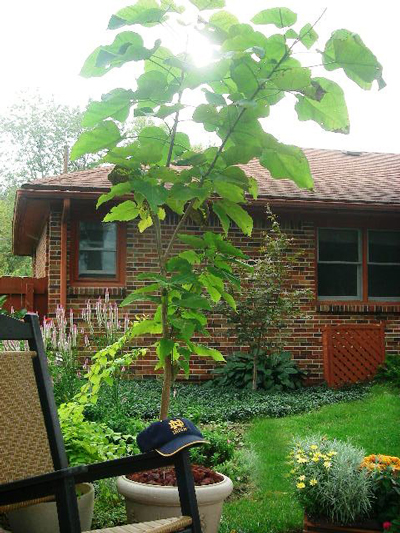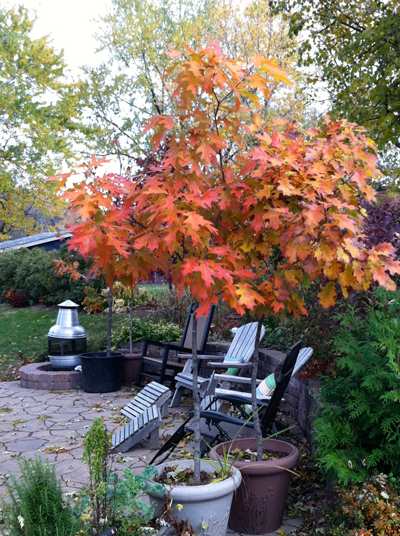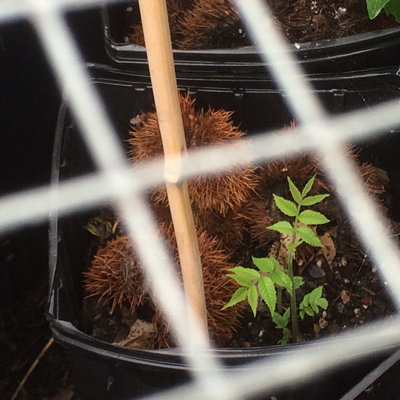Although flowers often go hand in hand with funerals, trees offer a more lasting tribute. What would you rather have, a spray of roses for a week or an awesome oak for a century?
You’ll see trees in arboreta, parks, and other public spaces dedicated to people who have gone before us. Many animal lovers plant a tree as a memorial to a beloved pet. Trees can also mark an important milestone, such as a graduation, wedding, or birth.
My dad planted trees for each of his seven children. He liked variety, so by the time he got to his youngest, I was stuck with a silver maple. Heck, we lived next door to the Highland Park arboretum, so he wasn’t lacking for inspiration. At least my silver maple grew faster than any of the other trees in our yard — giving me something to brag about.
I enjoy growing trees with special significance. The catalpa, above, is also known as cigar tree because of its slender brown seedpods. I found the volunteer seedling while visiting the University of Notre Dame, my dad’s alma mater. Groundskeepers eventually would have yanked out the interloper, so I brought it home with me. There’s something really satisfying about saving a doomed plant.
Then there are the two red oaks I discovered growing on my parents’ gravesite. The seedlings were so small I brought them back on the plane in coffee cups. Today they’re 8 feet tall and awaiting a permanent home. (I just need to find a special spot that won’t be disturbed for, oh, 200 years or so.)
Red oak trees are hardy to Zone 3 so Iowa’s cold winters haven’t been a problem for these Upstate transplants. I do have to cut the roots every other year so they don’t get rootbound. I also mulch the pots with leaves for winter insulation. Both of those extra steps will be unnecessary once the trees are planted for good.
By the way, my Rochester-born oaks march to their own drummer. They leaf out later in spring than their Midwestern relatives and take on fall color at their own pace, too. It makes them seem even more special to me.
There’s one other symbolic tree I’d like to tell you about: a black walnut seedling I found growing through the side of a raised bed. I dedicated the tree to a young man who’s experienced some teen growing pains. I’ve shown him pictures of the tree and pointed out that — just like him — it’s no quitter. I’m probably more interested in the tree’s symbolism than he will ever be. But it’s a convenient prop when he can use some encouragement.
That resourceful seedling has an interesting backstory: I brought a nut back with me from the historic Arbor Day Lodge in Nebraska. The nut lingered in my truck bed for weeks — somehow escaping the attention of foraging squirrels — until I got around to wrapping it in chicken wire and burying it in a raised bed for the winter. I soon forgot about it.
Black walnuts can take two years to germinate, so an entire season of vegetable gardening went on above the sleeping walnut. It wasn’t until the second summer that a wiry stem started squeezing through a seam so tight it would give a microbe reason to pause. Talk about the will to live! How can you let a tree with that sort of moxie die? I couldn’t.
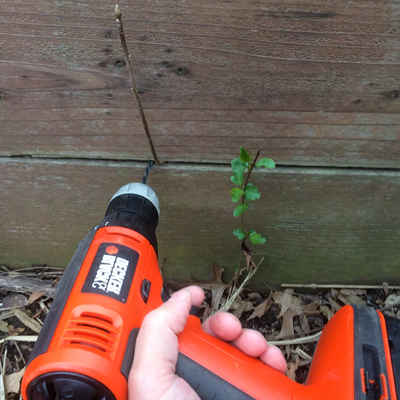
Tenacity alone was reason enough to save the seedling, so it was liberated from its confinement while dormant.
So this spring, when the seedling was dormant, I drilled a couple of holes around the stem to free it from its self-imposed prison. Although the stem was flattened, the roots were in good shape. That turned out to be important because soon after I replanted the tree, a squirrel separated said stem from said roots.
Not to worry; nature has provided black walnut seedlings with the means to resprout in such situations. This time I surrounded the sad-looking remnant with spiny chestnut burrs to discourage varmints if they got through the wire-mesh cage. Talk about killing with kindness: The burrs rested against the broken stem, trapping moisture and causing the replacement bud to become moldy and abort. Could this tree ever catch a break?
Yes, indeed. After moving the burrs back and going easy on the water, a brand new shoot arose like a phoenix from the roots. As you can see, it’s quickly developing into a tree—a special tree with a special significance.
Grow Your Own Tribute Tree
Would you like to grow a tree with special meaning? Search for seeds at the old family homestead, the park where you had your first picnic with your spouse, your alma mater, the hospital where your child or grandchild was born — the possibilities are endless. Many trees ripen seeds in fall, but there are some (such as elms, poplars, and soft maples) on a spring schedule. Oak is a great choice for a tribute tree because it symbolizes strength and can live for centuries. It’s also America’s National Tree. To see the author’s tips on sprouting oaks from acorns, visit www.lowes.com/lci-acorns.
Luke Miller is a native Rochesterian now living in Iowa. Visit his public Facebook page featuring tree photography and inspirational quotes at www.facebook.com/OldsmobileTrees. You can also access archives of his philosophical tree blog at www.lowes.com/reflections.
Views: 0




